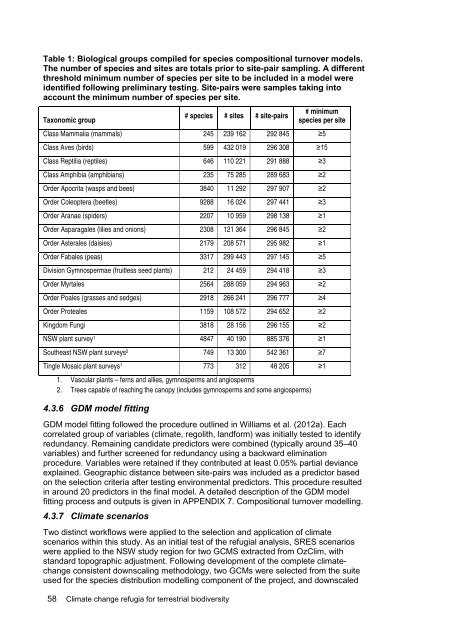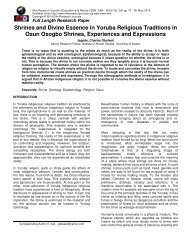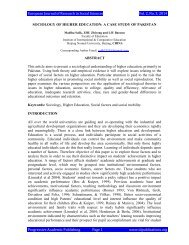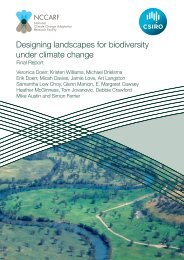Williams-Climate-change-refugia-for-terrestrial-biodiversity_0
Williams-Climate-change-refugia-for-terrestrial-biodiversity_0
Williams-Climate-change-refugia-for-terrestrial-biodiversity_0
Create successful ePaper yourself
Turn your PDF publications into a flip-book with our unique Google optimized e-Paper software.
Table 1: Biological groups compiled <strong>for</strong> species compositional turnover models.<br />
The number of species and sites are totals prior to site-pair sampling. A different<br />
threshold minimum number of species per site to be included in a model were<br />
identified following preliminary testing. Site-pairs were samples taking into<br />
account the minimum number of species per site.<br />
Taxonomic group<br />
58 <strong>Climate</strong> <strong>change</strong> <strong>refugia</strong> <strong>for</strong> <strong>terrestrial</strong> <strong>biodiversity</strong><br />
# species # sites # site-pairs<br />
# minimum<br />
species per site<br />
Class Mammalia (mammals) 245 239 162 292 845 ≥5<br />
Class Aves (birds) 599 432 019 296 308 ≥15<br />
Class Reptilia (reptiles) 646 110 221 291 888 ≥3<br />
Class Amphibia (amphibians) 235 75 285 289 683 ≥2<br />
Order Apocrita (wasps and bees) 3840 11 292 297 907 ≥2<br />
Order Coleoptera (beetles) 9288 16 024 297 441 ≥3<br />
Order Aranae (spiders) 2207 10 959 298 138 ≥1<br />
Order Asparagales (lilies and onions) 2308 121 364 296 845 ≥2<br />
Order Asterales (daisies) 2179 208 571 295 982 ≥1<br />
Order Fabales (peas) 3317 299 443 297 145 ≥5<br />
Division Gymnospermae (fruitless seed plants) 212 24 459 294 418 ≥3<br />
Order Myrtales 2564 288 059 294 963 ≥2<br />
Order Poales (grasses and sedges) 2918 266 241 296 777 ≥4<br />
Order Proteales 1159 108 572 294 652 ≥2<br />
Kingdom Fungi 3818 28 156 296 155 ≥2<br />
NSW plant survey 1 4847 40 190 885 376 ≥1<br />
Southeast NSW plant surveys 2 749 13 300 542 361 ≥7<br />
Tingle Mosaic plant surveys 1 773 312 48 205 ≥1<br />
1. Vascular plants – ferns and allies, gymnosperms and angiosperms<br />
2. Trees capable of reaching the canopy (includes gymnosperms and some angiosperms)<br />
4.3.6 GDM model fitting<br />
GDM model fitting followed the procedure outlined in <strong>Williams</strong> et al. (2012a). Each<br />
correlated group of variables (climate, regolith, land<strong>for</strong>m) was initially tested to identify<br />
redundancy. Remaining candidate predictors were combined (typically around 35–40<br />
variables) and further screened <strong>for</strong> redundancy using a backward elimination<br />
procedure. Variables were retained if they contributed at least 0.05% partial deviance<br />
explained. Geographic distance between site-pairs was included as a predictor based<br />
on the selection criteria after testing environmental predictors. This procedure resulted<br />
in around 20 predictors in the final model. A detailed description of the GDM model<br />
fitting process and outputs is given in APPENDIX 7. Compositional turnover modelling.<br />
4.3.7 <strong>Climate</strong> scenarios<br />
Two distinct workflows were applied to the selection and application of climate<br />
scenarios within this study. As an initial test of the <strong>refugia</strong>l analysis, SRES scenarios<br />
were applied to the NSW study region <strong>for</strong> two GCMS extracted from OzClim, with<br />
standard topographic adjustment. Following development of the complete climate<strong>change</strong><br />
consistent downscaling methodology, two GCMs were selected from the suite<br />
used <strong>for</strong> the species distribution modelling component of the project, and downscaled






